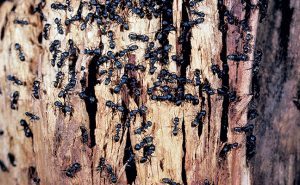
Carpenter ant nest in firewood Photo: Dr. Laurel Hansen
As mentioned in my previous article on this topic, Akre and Antonelli’s study from 1992 focused on the biology and behavior of carpenter ants in the genus Camponotus. The study also found that carpenter ants have a complex social structure, with multiple queens in some colonies and inter-colony aggression between neighboring colonies. The presence of competing colonies can lead to resource competition and increased aggression between colonies, which can affect the foraging behavior and distribution of individual colonies.
Furthermore, Akre and Antonelli’s study also identified several environmental factors that can affect the behavior and distribution of carpenter ants. Carpenter ants are sensitive to temperature and humidity, and their activity levels may increase or decrease depending on these factors. They also prefer to nest in wood that is decayed or moist, as it provides a suitable environment for the development of their colonies.
However, as noted in the study, carpenter ants can also be important predators of other insects and contribute to ecosystem health by controlling pest populations. They have been observed preying on a variety of insects, including termites, cockroaches, and other ants.
Hansen and Akre’s 1990 study investigated the population dynamics of carpenter ants in both parent and satellite nests. They found that parent nests typically have higher numbers of workers, broods, and queens compared to satellite nests. However, satellite nests can contribute significantly to the overall population of the colony, especially if they are located near food sources or if the parent nest becomes overcrowded.
Worker ants play an important role in redistributing resources between parent and satellite nests. They frequently move between nests, carrying food, brood, and other resources with them. This helps to balance the population dynamics of the colony and ensure that resources are distributed efficiently.
Carpenter ants can be active in the spring, as well as other times of the year, depending on the location and environmental conditions. In general, carpenter ants become more active during warm weather, and they may emerge from their nests to forage for food and water. This can be particularly common in the spring, as temperatures begin to warm up and food sources become more abundant.
It’s important to be aware of the signs of carpenter ant activity, as they can cause significant damage to wooden structures over time. Some common signs of carpenter ant activity include the presence of sawdust piles, rustling sounds inside walls, and the emergence of winged ants from the colony.
Winged carpenter ants, also known as swarmers or alates, are reproductive ants that have developed wings and are capable of leaving their nests to mate and start new colonies. Winged carpenter ants are typically larger than other ants in the colony and have clear, veined wings that are longer than their bodies. During the spring and summer months, winged carpenter ants will emerge from their nests in large numbers in a behavior known as swarming. Swarming typically occurs on warm, humid days and can last for several hours. In Minnesota, winged carpenter ants may be seen as early as April, although this is less common than sightings in May or June. Mid-June and mid-July are common times for carpenter ants to swarm in Minnesota, as these months typically have warm, humid weather that is ideal for reproductive activity. Winged carpenter ants may also be seen in mid-August, although this is towards the end of the typical swarming season. After winged carpenter ants emerge from their nest during the mating flight, their primary goal is to find a mate and establish a new colony. The males typically die soon after mating, while the fertilized females, known as queens, search for a suitable location to start a nest.
Once a queen finds a suitable location, she will shed her wings and begin excavating a chamber in the wood to lay her eggs. She will then use stored sperm from the mating flight to fertilize the eggs and begin the process of establishing a new colony. The queen will care for the eggs and larvae until they develop into adult workers, who will take over the tasks of foraging for food, caring for the brood, and expanding the nest. It’s worth noting that not all winged carpenter ants that emerge during the mating flight are successful in establishing new colonies. Many may fall victim to predators or environmental factors, while others may not find suitable nest sites or mates. However, even unsuccessful mating flights can contribute to the genetic diversity and overall health of carpenter ant populations.
Hansen and Akre’s 1985 study provides important insights into the mating behavior of carpenter ants and the establishment of new colonies by queens. The success of colony establishment by the queen is influenced by a variety of factors, including the availability of suitable nest sites and the presence of workers to assist with brood care and nest construction.
In addition, the study found that the presence of competing queens in the same area can reduce the success rate of colony establishment, as they may engage in aggressive behavior toward each other. However, when multiple queens are able to establish colonies in close proximity to each other, they may form interconnected colonies, which can allow for increased genetic diversity and resource sharing.
Leave A Comment